CHESSAGON
DESCRIPTION
CHESSAGON is a chess variant based on a hexagonal board of dark and light triangles. It has all the standard chess pieces you would expect: King, Queen, Knight, Bishop, Rook, and Pawn; plus a new piece called the Duke. The rules adhere to a purist interpretation of traditional Chess rules, but on a hexagonal board of 96 triangles instead of 64 squares; with the pieces moving on six axes instead of four. The Duke is similar to a Bishop or a Rook in that it is able to move in straight lines across the board. The Knight can move to any of 12 spaces. The Queen moves like a combination of the Duke, the Bishop, and the Rook. The King can move one space in any of 12 directions. The number of pawns has been increased to create an appropriate wall of pawns protecting each side. A 1:2 ratio of pieces to board spaces is maintained like traditional Chess. Chessagon has a 48:96 ratio of pieces to spaces compared to traditional Chess which has a 32:64 ratio of pieces to spaces.
CHESSAGON followers and forums:
Chessagon@Pinterest
Chessagon@Facebook
AVAILABILITY
CHESSAGON further infromation and availabilty at:
ChessagonApp@GitHub
ChessagonApp@GitLab
CHESSAGON boards and stickers are available at:
ChessagonBoards@Zazzle
Setup
Initial Piece Placement
To begin the game, the playing pieces are arranged on the board as shown in the diagram. Note that both the white Queen and the black Queen begin on a dark space. The player with the white pieces moves first, and the players alternate turns thereafter.
![]()
PIECE LEGEND
![]()
King(K), Queen(Q), Duke(D), Bishop(B), Duke(D), Knight(N), Rook(R), Pawn(P)
CHESSAGON Official Rules withe detailed diagrams are posted here:
ChessagonRules@GitHub
ChessagonRules@GitLab
Pieces
External image links detected!
You know what would look worse on your page than this big, ugly warning? Broken image links. If you're the author, please make sure that doesn't happen to this page by replacing the following external graphic images with local copies.
Array
(
[3] => https://the8kengineer.github.io/chessagon-app/assets/rulesimages/ExampleDM1-300x300.png
[4] => https://the8kengineer.github.io/chessagon-app/assets/rulesimages/ExampleDM2-300x300.png
[5] => https://the8kengineer.github.io/chessagon-app/assets/rulesimages/ExampleDC1-300x300.png
[6] => https://the8kengineer.github.io/chessagon-app/assets/rulesimages/ExampleDC2-300x300.png
[8] => https://the8kengineer.github.io/chessagon-app/assets/rulesimages/ExampleQM1-300x300.png
[9] => https://the8kengineer.github.io/chessagon-app/assets/rulesimages/ExampleQM2-300x300.png
[10] => https://the8kengineer.github.io/chessagon-app/assets/rulesimages/ExampleQC1-300x300.png
[11] => https://the8kengineer.github.io/chessagon-app/assets/rulesimages/ExampleQC2-300x300.png
[13] => https://the8kengineer.github.io/chessagon-app/assets/rulesimages/ExampleNM1-300x300.png
[14] => https://the8kengineer.github.io/chessagon-app/assets/rulesimages/ExampleNM2-300x300.png
[15] => https://the8kengineer.github.io/chessagon-app/assets/rulesimages/ExampleNC1-300x300.png
[16] => https://the8kengineer.github.io/chessagon-app/assets/rulesimages/ExampleNC2-300x300.png
[17] => https://the8kengineer.github.io/chessagon-app/assets/rulesimages/ExampleNQ1-300x300.png
[18] => https://the8kengineer.github.io/chessagon-app/assets/rulesimages/ExampleNQ2-300x300.png
[19] => https://the8kengineer.github.io/chessagon-app/assets/rulesimages/ExampleNQ3-300x300.png
[20] => https://the8kengineer.github.io/chessagon-app/assets/rulesimages/ExampleNQ4-300x300.png
[22] => https://the8kengineer.github.io/chessagon-app/assets/rulesimages/ExampleKM3-300x300.png
[23] => https://the8kengineer.github.io/chessagon-app/assets/rulesimages/ExampleKM4-300x300.png
[24] => https://the8kengineer.github.io/chessagon-app/assets/rulesimages/ExampleKC2-300x300.png
[25] => https://the8kengineer.github.io/chessagon-app/assets/rulesimages/ExampleKC3-300x300.png
[26] => https://the8kengineer.github.io/chessagon-app/assets/rulesimages/ExampleKC5-300x300.png
[27] => https://the8kengineer.github.io/chessagon-app/assets/rulesimages/ExampleKC6-300x300.png
[28] => https://the8kengineer.github.io/chessagon-app/assets/rulesimages/ExampleKR1-300x300.png
[29] => https://the8kengineer.github.io/chessagon-app/assets/rulesimages/ExampleKR2-300x300.png
[30] => https://the8kengineer.github.io/chessagon-app/assets/rulesimages/ExampleKR3-300x300.png
[31] => https://the8kengineer.github.io/chessagon-app/assets/rulesimages/ExampleKR4-300x300.png
[33] => https://the8kengineer.github.io/chessagon-app/assets/rulesimages/ExamplePO1-300x300.png
[34] => https://the8kengineer.github.io/chessagon-app/assets/rulesimages/ExamplePO2-300x300.png
[35] => https://the8kengineer.github.io/chessagon-app/assets/rulesimages/ExamplePO3-300x300.png
[36] => https://the8kengineer.github.io/chessagon-app/assets/rulesimages/ExamplePO4-300x300.png
[37] => https://the8kengineer.github.io/chessagon-app/assets/rulesimages/ExamplePR1-300x300.png
[38] => https://the8kengineer.github.io/chessagon-app/assets/rulesimages/ExamplePR2-300x300.png
[39] => https://the8kengineer.github.io/chessagon-app/assets/rulesimages/ExamplePC1-300x300.png
[40] => https://the8kengineer.github.io/chessagon-app/assets/rulesimages/ExamplePC2-300x300.png
[41] => https://the8kengineer.github.io/chessagon-app/assets/rulesimages/ExamplePC3-300x300.png
[42] => https://the8kengineer.github.io/chessagon-app/assets/rulesimages/ExamplePC5-300x300.png
[43] => https://the8kengineer.github.io/chessagon-app/assets/rulesimages/ExamplePE1-300x300.png
[44] => https://the8kengineer.github.io/chessagon-app/assets/rulesimages/ExamplePE2-300x300.png
[45] => https://the8kengineer.github.io/chessagon-app/assets/rulesimages/ExamplePE3-300x300.png
[46] => https://the8kengineer.github.io/chessagon-app/assets/rulesimages/ExamplePE4-300x300.png
[47] => https://the8kengineer.github.io/chessagon-app/assets/rulesimages/ExamplePP1-300x300.png
[48] => https://the8kengineer.github.io/chessagon-app/assets/rulesimages/ExamplePP2-300x300.png
)
General Piece Movement and Capture
For simplicity in describing the moves, the vertices of the triangular spaces will be referred to as points, and the sides of the triangular spaces will be called faces. For example, a move may be described as: face-to-face, point-to-point, or points adjacent. Pieces may also be described as moving along a row (a series of triangular spaces in a straight line). A row (also a rank, file, or column) can be a series of triangular spaces with:
- face-to-face alignment that alternate in color
- alternating point-to-point and then face-to-face alignment that alternate in color
- points adjacent alignment that are all the same color, a "triangular-diagonal" (similar to same color square-diagonals on square chess boards)
All captures are made by landing on a triangular space occupied by an opponent’s piece and removing the opponent’s piece from the board.
For each piece movement and capture section below, all piece movements and potential captures are marked with red highlighted triangles in the pictured diagrams.
BISHOP 
Movement
The Bishop moves using "triangular-diagonals" any number of same colored spaces points-adjacent along straight rows in any of six directions along three different axes, as long as it is not blocked by another piece. If another piece is on an opposite color space, the Bishop is not blocked and can proceed past that piece. A Bishop must remain on the same color of spaces for the entire duration of the game. Each player gets a dark space and a light space Bishop.
Capture
The Bishop captures in the same way that it moves. It can stop on a space of the same color, capturing any opponent’s piece that is there.
ROOK 
Movement
The Rook moves any number of spaces face-to-face along straight rows (ranks, columns or files) in any of six directions along three different axes, as long as it is not blocked by another piece.
Capture
The Rook captures in the same way that it moves. It can stop on a space of either color, capturing any opponent’s piece that is there.
DUKE 
Movement
The Duke moves any number of spaces face-to-face then point-to-point in a straight row (ranks, columns or files), in any of six directions along three axes, unless blocked by another piece.
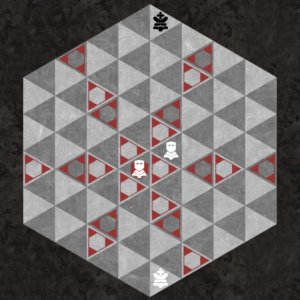
Duke Moves From Left Center
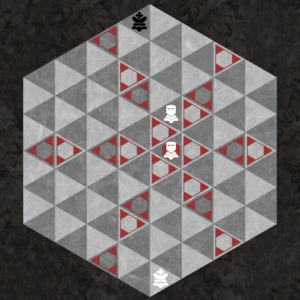
Duke Moves From Right Center
Capture
The Duke captures in the same way that it moves. It can stop on a space of either color, capturing any opponent’s piece that is there.
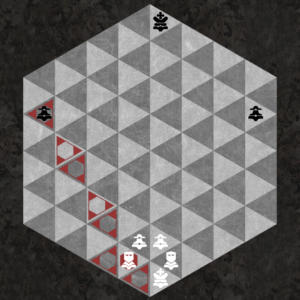
Duke Captures On Left
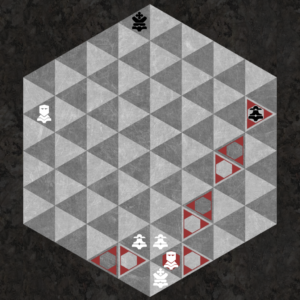
Duke Captures On Right
QUEEN 
Movement
The Queen is the most powerful piece. It can move any number of spaces in any way that a Duke, a Rook, or a Bishop can move; as long as it is not blocked by another piece.
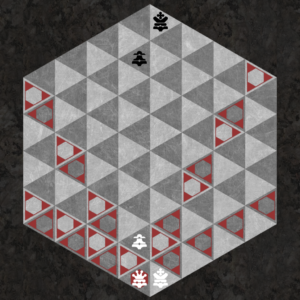
Queen Moves Like Bishop, Rook, and Duke
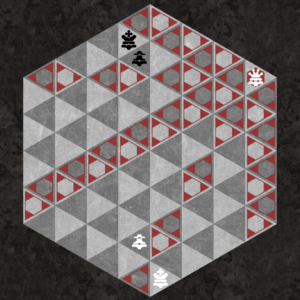
Queen Moves Can Reach Each Side of Board
Capture
The Queen also captures in the same manner as the Duke, the Rook, or the Bishop. It can stop on a space of either color, capturing any opponent’s piece that is there.
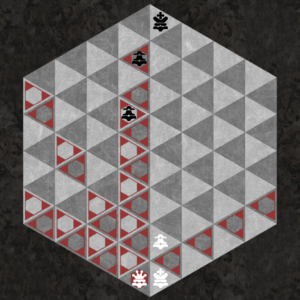
Queen Threatens Both Pawns
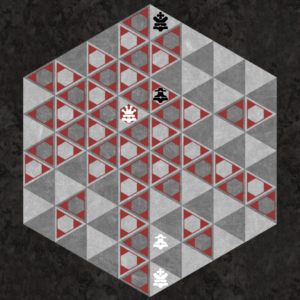
Queen Threatens Broad Circumference
KNIGHT 
Movement
The Knight jumps to one of twelve spaces of the opposite color, just beyond the triangle of spaces that surrounds it. The Knight is the only piece that can jump over other pieces on the board. It always moves to a space of the opposite color than it currently occupies.
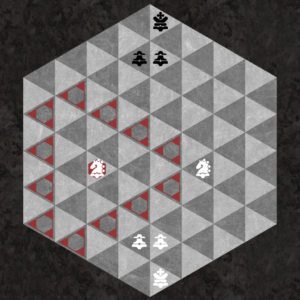
Knight Moves From Left
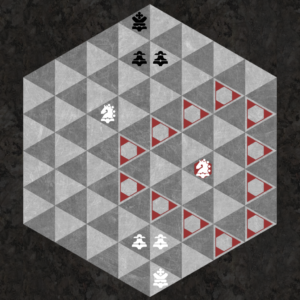
Knight Moves From Right
Capture
The Knight captures in the same way that it moves. It always captures to a space of the opposite color than it currently occupies, capturing any opponent’s piece that is there.
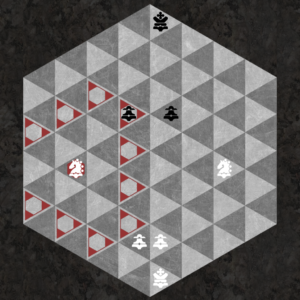
Knight Captures On Left
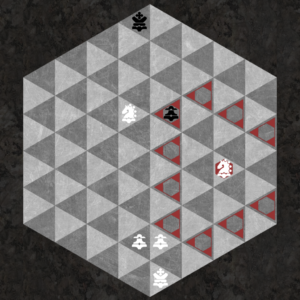
Knight Captures On Right
Beyond the Queen
The Knight is the only piece that can position itself beyond the reach and threat of a Queen, but still capture the Queen. The ability of the knight to jump over over pieces and have an extended reach keeps the power of the Queen in check.
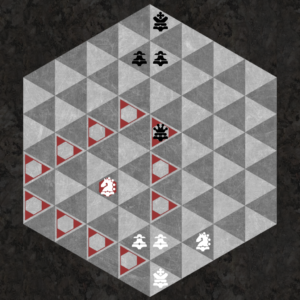
1st: Knight On Left Threatens Queen
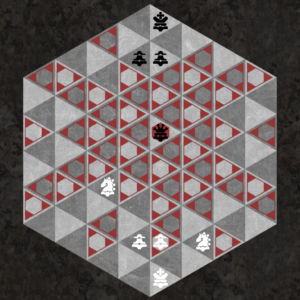
2nd: Both Knights Are Beyond Queen’s Threat
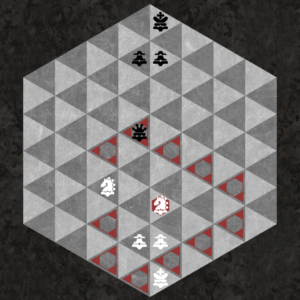
3rd: Knight On Right Moves to Threaten Queen
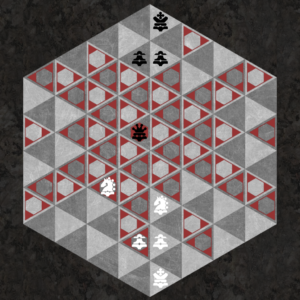
4th: Knight On Right Beyond Queen’s Threat, Covers Knight On Left
KING 
Movement
The King can move to any one of twelve 12 spaces surrounding itself. This move can be one space face-to-face, one space point-to-point, or one space with points adjacent to the King’s current position. Essentially the King can move one space like a Rook, Duke, or Bishop. The King may never move into check, which is any space currently vulnerable to attack by an opponent’s piece.
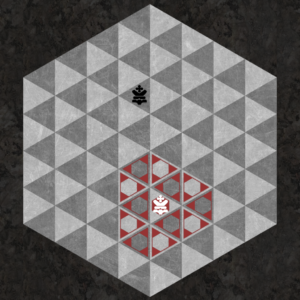
King Moves For White
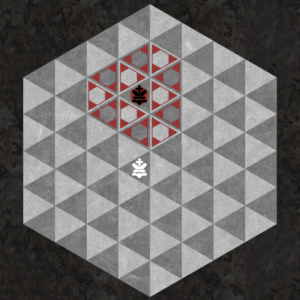
King Moves For Black
Capture
The King captures in the same way that it moves. If the King is in check, it must be moved out of check before any other move can be made. There are three ways to accomplish this:
1) move the King to another space
2) block the attack with another piece
3) capture the attacking piece
If the King cannot be taken out of check in a single move, the King is considered to be in checkmate; and the game is over.
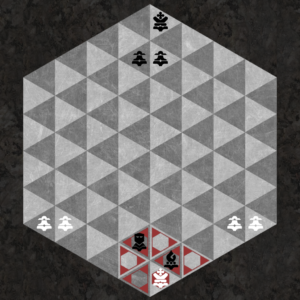
1st: King Threatened By Duke
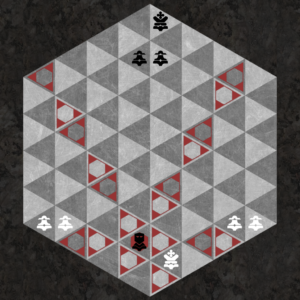
2nd: King Takes Bishop, Beyond Duke’s Threat
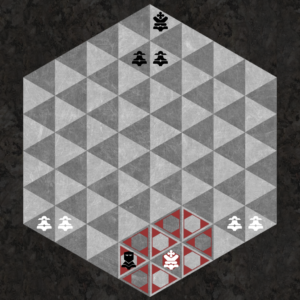
3rd: King Threatened By Duke Again
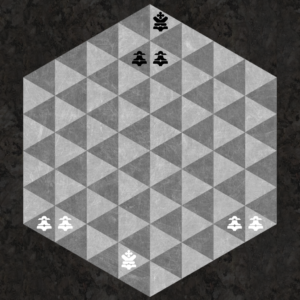
4th: King Takes Duke
Castling
The King can make a castling move, which must be at least one space further than it normally moves, and involves repositioning a Rook to the opposite side of the King. There are actually four total positions that a King's castling movement can reach, two on the left and two on the right. Neither the King nor the Rook may have been previously moved during the course of the game. The King may castle either toward the Rook on the left or the Rook on the right. There cannot be any piece(s) of either color between the King and the Rook in order for castling to take place. Each player may only castle once during a game. The King may not castle out of check or through check.
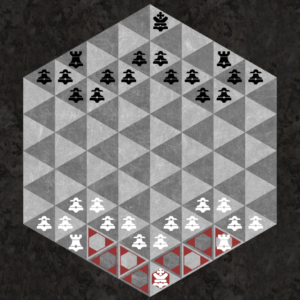
1st: White King Can Castle Either Direction
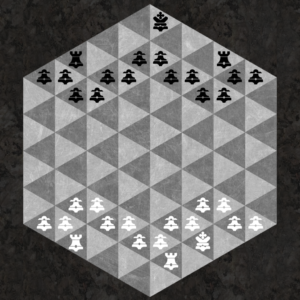
2nd: White King Castles Right
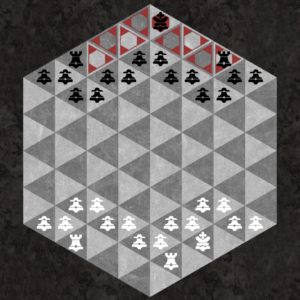
3rd: Black King Can Castle Either Direction
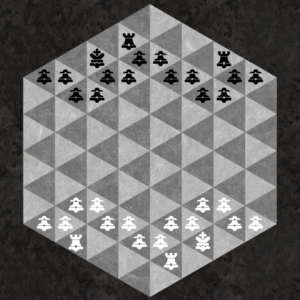
4th: Black King Castles Left
PAWN 
Opening Movement
The Pawn can move two spaces forward point-to-point then face-to-face, or two spaces forward face-to-face then point-to-point on its opening move.
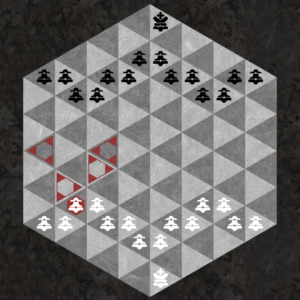
1st: White Pawn On Left Opening Movements
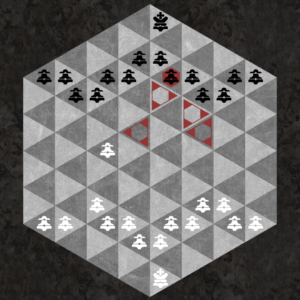
2nd: Black Pawn On Right Opening Movements
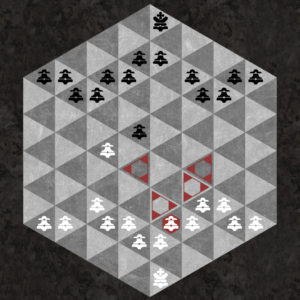
3rd: White Pawn On Right Opening Movements
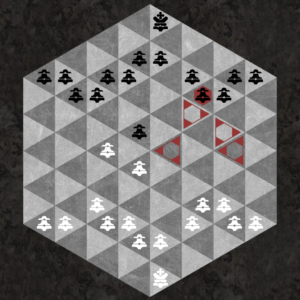
4th: Black Pawn On Right Opening Movements
Regular Movement
The Pawn moves forward one space to a space of the opposite color, point-to-point or face- to-face from its current position. It cannot move laterally or backward. Other than the Pawn’s first move of the game, it usually has a choice of two spaces to which it can move at any one time.
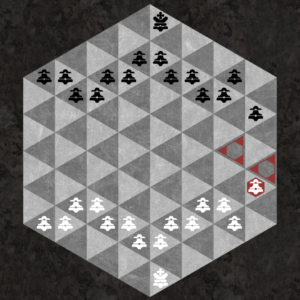
White Pawn Regular Moves
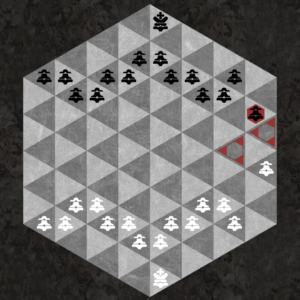
Black Pawn Regular Moves
Regular Capture
The Pawn captures an opponent’s piece by moving forward in a "triangular-diagonal" manner to a space of the same color, with points adjacent to its current space. Other than the En Passant capture, it usually has three spaces to which it can capture at any one time.
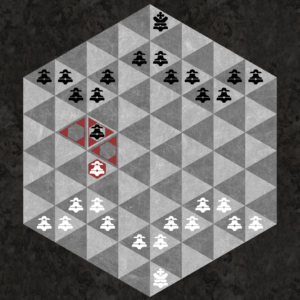
White Pawn On Left With One Regular Capture
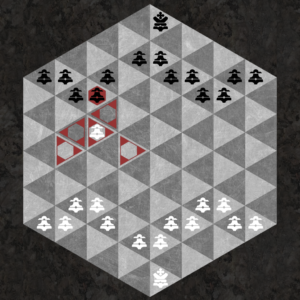
Black Pawn On Left With One Regular Capture
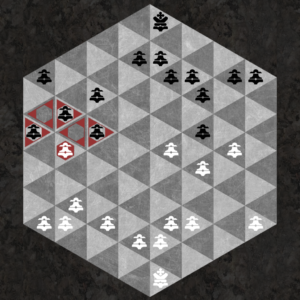
White Pawn On Left With Three Regular Captures

Black Pawn On Right With Three Regular Captures
En Passant Capture
A special way that a Pawn can capture is called En Passant. This type of capture occurs when a Pawn on opening movement is moved two spaces forward, in an attempt to avoid capture by the opponent’s Pawn. The fleeing Pawn is captured by the opponent’s Pawn the same as if the player had moved the fleeing Pawn only one space forward.
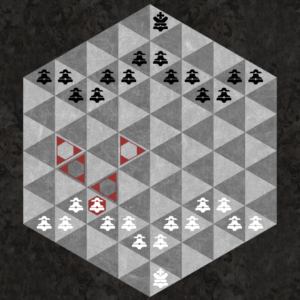
1st: White Pawn On Left Opening Movement

2nd: Black Pawn On Left Opening Movement
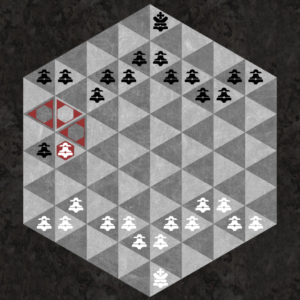
3rd: White Pawn On Left Threatens Space Behind Black Pawn
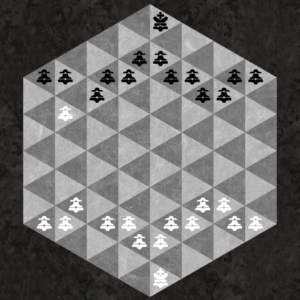
4th: White Pawn on Left Takes Black Pawn As If Black Pawn Only Moved One Space
Rank Promotion
If a Pawn advances all the way across the board to any one of the eight spaces at the back edge of the opponent’s side of the board, that Pawn is immediately promoted to another piece, typically a Queen. If this occurs, it is possible for a player to have more than one Queen or more than two Dukes, Rooks, Bishops or Knights.
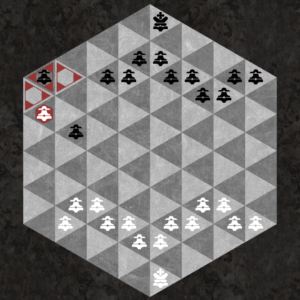
1st: White Pawn On Right Prepared to Capture Black Pawn On Back Row
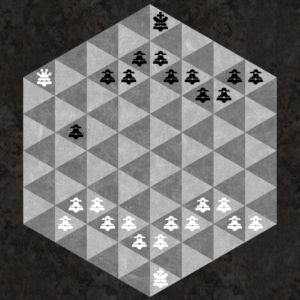
2nd: White Pawn Promoted To White Queen, Threatening Black King
Rules
OBJECTIVE
Chessagon is a strategy game for two players. The game consists of a hexagon shaped board with 96 triangular spaces and 48 playing pieces. There are seven types of pieces: King, Queen, Duke, Bishop, Knight, Rook and Pawn. The object of the game is to maneuver the pieces in such a way that the opponent’s King becomes trapped and cannot escape. This is called checkmate.
INTENT
The principal difference between Chess and Chessagon is that you are playing on triangles instead of squares. Chessagon was intended to be as close to standard Chess as possible except for those changes necessary to implement Chess on a board of triangles instead of squares. To illustrate, consider the following points:
- Bishops move on only one color in a "diagonal" manner. For a board of triangles, that becomes points-adjacent, or "triangular-diagonal" spaces.
- Rooks move along rows, columns or files of face-to-face spaces that alternate in color.
- Pawns can regularly move forward to opposing color spaces, for triangles that is either face-to-face or point-to-point.
- Pawns can regularly capture on the "triangular-diagonal" to same color spaces.
- Pawns can promote once reaching the other side of the board.
- Queens move like all the other major pieces except the Knight.
- Kings can move like Queens, but only the distance of one space.
- Kings can castle twice as far as they can normally move, using a Rook to block potential threats from where they just moved.
- Knights can threaten a Queen without being threatened by the Queen themselves, which is crucial for keeping the Queen's absolute power in check.
The Chessagon board orientation of playing corner to corner, rather than side-to-side, on a hexagonal board of triangles is also unique feature. Playing from opposing corners allows the game to be closely analogous to standard chess. It also helps the Pawns have fundamentally similar moves and captures on triangles as compared to squares.
- Since the number of board spaces increased by 50% (64 squares vs 96 triangles, an addition of 32 spaces) the total piece count also increased by same percentage of 50% and ratio of 16:24 per side.
- Since the board has six axes of movement on triangles instead of four axes of movement on squares, it is also a 50% increase in ability to move and capture for each of the pieces.
An addition to Chess that Chessagon makes, is for the piece called the Duke. It was logical and necessary to create the Duke to account for the expansion of fundamental board geometry. The geometry of the board demanded and dictated the need for the piece to be created to account for the increased axes of movement on the board. A Duke is analogous to a Rook. It can reach any space on the board, but its movement is rotated 30 degrees from that of a Rook. Its power level is less than that of a Rook, but slightly superior to a Knight. A Duke's movement allows it to "squeeze" between adjacent pieces as it moves across the board.
Notes
HISTORY
CHESSAGON® was created in the summer of 1977 by two brothers, Kerry Langford and Eric Langford, as a remedy for boredom and as an attempt to create a strategy game more intricate than traditional Chess, yet tactically just like Chess. The board size, orientation, and the invention of the Duke piece were all settled during that initial summer of 1977. A lot play testing was done to try alternative piece setups, variations on Pawn opening moves, and the number of Pawns in the front ranks in subsequent years. Rules for En Passant and Castling were the last items to be completed. Kerry's wife, Debra Langford, helped revise and grammar check various forms of the rule books over the years to share with family members. Eric Langford has done much proof reading and editing of the rules over the entire span of 40+ years. Kerry's son, Preston Langford, is credited with creating the first computer version of the CHESSAGON® game with a playable AI. Preston Langford also made the game with an online mode for playing and sharing games with other players remotely over the internet on Apple iOS devices (iPod, iPhone, and iPad) during during 2017 and 2018. An update to the app was published in 2020 through 2023.
LEGAL
CHESSAGON® was a Registered Trademark of SiliconLoom, LLC from December 19th, 2018 through December 19th, 2023.
Game Concept and Rules © 1977-2024
- Kerry Langford
- Eric Langford
- Debra Langford
 This 'user submitted' page is a collaboration between the posting user and the Chess Variant Pages. Registered contributors to the Chess Variant Pages have the ability to post their own works, subject to review and editing by the Chess Variant Pages Editorial Staff.
This 'user submitted' page is a collaboration between the posting user and the Chess Variant Pages. Registered contributors to the Chess Variant Pages have the ability to post their own works, subject to review and editing by the Chess Variant Pages Editorial Staff.
By Kerry Langford.
Last revised by Kerry Langford.
Web page created: 2018-04-22. Web page last updated: 2021-02-09
